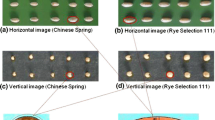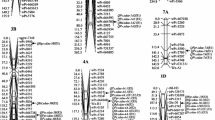Abstract
The soft winter wheat variety, Kitahonami, shows a superior flour yield in comparison to other Japanese soft varieties. In order to map quantitative trait loci (QTL) associated with the flour-yield trait, association mapping was performed using panel lines in Kitahonami’s pedigree, along with leading varieties and advanced breeding lines. Using a mixed linear model corrected for kernel types and familial relatedness, 62 marker-trait associations were identified and classified into 21 QTLs. Five out of eight QTLs tested were validated by linkage analyses using three sets of doubled haploid populations from crosses in which Kitahonami was used as a parent. Among them, QTLs on 3B and 7A chromosome showed highly significant effects and consistency across the three populations. A joint linkage map of 3B showed that the QTL on this chromosome was located at the same interval across the populations. By applying a meta-analysis approach, we have succeeded in identifying QTLs with consistent contributions to high flour yield across various genetic backgrounds.
You have full access to this open access chapter, Download conference paper PDF
Similar content being viewed by others
Keywords
These keywords were added by machine and not by the authors. This process is experimental and the keywords may be updated as the learning algorithm improves.
Introduction
Flour yield is of great interest to milling companies. Thus, breeding of wheat varieties with higher flour yield, in addition to enhancement of milling techniques, is important to flour milling industries. In 2006, a soft winter wheat variety, Kitahonami, was released in the Hokkaido prefecture of Japan (Yanagisawa et al. 2007). It has a superior flour yield compared to other Japanese soft varieties (Fig. 34.1) and has become a leading variety in the Hokkaido area. Kitahonami is also being used as a source of the high flour-yield trait in all Japanese wheat breeding programs. Mapping of quantitative trait loci (QTL) associated with the flour-yield trait and identification of linked markers would accelerate the development of varieties with high flour yield.
QTL studies using bi-parental populations have been conducted within hard wheat populations or within populations derived from hybridizing hard and soft wheat. These studies have revealed that reliable QTLs for flour yield are located on 16 out of 21 chromosomes: 1B, 1D, 2A, 2B, 3A, 3B, 4A, 4B, 4D, 5A, 5B, 5D, 6B, 6D, 7A and 7D (Parker et al. 1999; Campbell et al. 2001; Smith et al. 2001; Lehmensiek et al. 2006; Fox et al. 2013). Interclass hybridization between soft and hard wheat indicated that the hardness locus Pinb on 5D had a strong influence on flour yield (Campbell et al. 2001). Fox et al. (2013) detected a QTL explaining the highest phenotypic variance close to the plant height locus, Rht-D1 located on 4D. For soft wheat populations, only a few studies have been reported to date. Using an association mapping approach, Breseghello and Sorrells (2006) detected weak QTLs associated with flour yield and break flour yield on 2D and 5B. One bi-parental population derived from two soft wheat cultivars revealed QTLs for flour yield, flour protein, softness equivalent, and solvent retention capacities (Smith et al. 2011), the majority of which were located on 1B and 2B. Carter et al. (2012) found that a large number of QTLs including QTLs for flour yield were located on 3B and 4D and coincided with traits for milling quality and starch functionality. Although these QTLs were detected with high confidence, few were detected in more than one study, indicating that flour yield is a complex trait strongly influenced by genetic background.
The objective of this study was to dissect genetic factors contributing to the high flour-yield trait of Kitahonami and to find effective QTLs and associated markers that can be used for MAS in our breeding programs.
Materials and Methods
Plant Materials
Sixty-five winter wheat accessions consisting of Kitahonami and its related lines were used. Lines were field-grown with two replications at three locations, Kitami (Hokkaido island), Tohoku (Northern Honsyu island) and Nagano (Central of Honsyu island) during three successive cropping seasons from 2008/2009 to 2010/2011. Grain samples were harvested from each replicated plot.
Milling
Samples were milled on a Quadrumat Junior mill (Brabender Co.). Flour yield was expressed as the percentage of total flour weight to initial sample weight.
Genotyping
All accessions were genotyped by SNP (Cavanagh et al. 2013), SSR (GrainGenes 2.0), DArT (Diversity Arrays Technology, Pty Ltd.) and established diagnostic markers for Pina-D1, Pinb-D1 Wx-A1, Wx-B1, Ppo-A1, Ppo-D1, Psy-A1 and Psy-B1 (review in Liu et al. 2012). After removing data with minor allele frequencies of less than 0.1, genotypes from 3,815 markers were used for association analysis.
Association Analysis
Association between markers and trait was tested with TASSEL 3.0 (Bradbury et al. 2007) using the mixed linear model. Since a different distribution pattern was observed between soft and hard kernel type (Fig. 34.1), the effect of kernel type was considered in the model. Kinship matrix calculated by TASSEL was used for considering familial relatedness of accessions. To take into account multiple comparisons, significance was tested using a 0.5 false discovery rate implemented in the q value software (Storey and Tibshirani 2003).
QTL Validation
QTLs were validated using three doubled haploid (DH) populations from crosses in which Kitahonami was used as a parent. DH populations were field-grown without replication during the 2010/2011 season. Flour yield values were obtained with the same method described above. Differences between allele mean values were tested for each combination of QTL and population. For the 3B chromosome, linkage map construction and QTL analysis were conducted by MapDist 1.74 (Lorieux 2012) and QTL IciMapping 3.25 (Li et al. 2007), respectively.
Results and Discussion
Analysis of variance indicated there was a significant genetic variation in flour yield among accessions compared to residual errors (location, year, interaction) (data not shown). Correlations across nine environments ranged from 0.394 to 0.891 (average 0.682), indicating that relative differences among accessions were consistent over the environments. Thus, accession means of all environments were used for association analysis.
By association analysis using a mixed linear model corrected for kernel type and familial relatedness, 62 marker-trait associations were identified. Based on the locations of the markers, they were classified into 21 QTLs (Table 34.1). Due to the lack of common markers, it was difficult to compare positions of QTLs detected in this study to those of previous reports. However, based on the microsatellite consensus map (Somers et al. 2004), it is possible that the QTLs on 2B.1, 2B.2, 3B.2, 6A.2 and 7A observed here are the same as those reported by Smith et al. (2001), Lehmensiek et al. (2006), Carter et al. (2012), Fox et al. (2013) and Lehmensiek et al. (2006), respectively.
Segregation analysis revealed five out of eight QTLs tested had significant effects on flour yield in at least one of three populations (Table 34.2). QTLs on 3B and 7A showed highly significant effects and consistency across the populations. A joint linkage map from the three populations showed that the 3B QTL interval was around 6 cM, located between the markers snp5325 and wmc612 (Fig. 34.2). This QTL (LOD score 6.1) explained 6.0 % of the total variation. In addition to the DH populations, the 3B QTL was also detected among materials derived from crosses with Kitahonami in three separate breeding programs (data not shown).
Performing milling tests is time-consuming and requires a fairly large amount of grain. Thus, it can be a rate-limiting step in wheat breeding programs. By applying a meta-analysis approach, we have succeeded in identifying a QTL on 3B which was consistently associated with high flour yield across different genetic backgrounds. Introducing this QTL into Japanese soft varieties by marker-assisted selection is a promising method of improving flour yield. The results obtained in this study also provide us with a starting point for the isolation of candidate gene(s), which will lead to a better understanding of the mechanisms governing flour yield.
References
Bradbury PJ, Zhiwu Zhang Z, Kroon DE et al (2007) TASSEL: software for association mapping of complex traits in diverse samples. Bioinformatics 23:2633–2635
Breseghello F, Sorrells ME (2006) Association mapping of kernel size and milling quality in wheat (Triticum aestivum L.) cultivars. Genetics 172:1165–1177
Campbell KG, Finney PL, Bergman CJ et al (2001) Quantitative trait loci associated with milling and baking quality in a soft x hard wheat cross. Crop Sci 41:1275–1285
Carter AH, Campbell KG, Morris CF, Kidwell KK (2012) Chromosomes 3B and 4D are associated with several milling and baking quality traits in a soft white spring wheat (Triticum aestivum L.) population. Theor Appl Genet 124:1079–1096
Cavanagh CR, Chao S, Wang S et al (2013) Genome-wide comparative diversity uncovers multiple targets of selection for improvement in hexaploid wheat landraces and cultivars. Proc Natl Acad Sci U S A 110:8057–8062
Fox GP, Martin A, Kelly AM et al (2013) QTLs for water absorption and flour yield identified in the doubled haploid wheat population Lang/QT8766. Euphytica 192:453–462
Huang BE, George AW, Forrest KL et al (2012) A multiparent advanced generation inter-cross population for genetic analysis in wheat. Plant Biotechnol J 10:826–839
Lehmensiek A, Eckermann PJ, Verbyla AP et al (2006) Flour yield QTLs in three Australian doubled haploid wheat populations. Aust J Agric Res 57:1115–1122
Li H, Ye G, Wang J (2007) A modified algorithm for the improvement of composite interval mapping. Genetics 175:361–374
Liu Y, He Z, Appels R, Xia X (2012) Functional markers in wheat: current status and future prospects. Theor Appl Genet 125:1–10
Lorieux M (2012) MapDisto: fast and efficient computation of genetic linkage maps. Mol Breed 30:1231–1235
Parker GD, Chalmers KJ, Rathjen AJ, Langridge P (1999) Mapping loci associated with milling yield in wheat (Triticum aestivum L.). Mol Breed 5:561–568
Smith AB, Cullis BR, Appels R et al (2001) The statistical analysis of quality traits in plant improvement programs with application to the mapping of milling yield in wheat. Aust J Agric Res 52:1207–1219
Smith N, Guttieri M, Souza E et al (2011) Identification and validation of QTL for grain quality traits in a cross of soft wheat cultivars Pioneer Brand 25R26 and Foster. Crop Sci 51:1424–1436
Somers DJ, Isaac P, Edwards K (2004) A high-density microsatellite consensus map for bread wheat (Triticum aestivum L.). Theor Appl Genet 109:1105–1114
Storey JD, Tibshirani R (2003) Statistical significance for genomewide studies. Proc Natl Acad Sci U S A 100:9440–9445
Yanagisawa A, Yoshimura Y, Amano Y et al (2007) A new winter wheat (Triticum aestivum) variety ‘Kitahonami’. Bull Hokkaido Prefectural Agric Exp Station 91:1–13 (in Japanese)
Acknowledgments
The authors thank Drs. Fuminori Kobayashi, Shiaoman Chao and Andrezej Kilian for their support in the molecular analyses of our materials. We also thank Dr. Patricia Vrinten for her useful comments on the manuscript. This work was partially supported by a grant from the Ministry of Agriculture, Forestry and Fisheries of Japan (TRG-1009, NGB-1002 and NGB-2004).
Author information
Authors and Affiliations
Corresponding author
Editor information
Editors and Affiliations
Rights and permissions
Open Access This chapter is distributed under the terms of the Creative Commons Attribution Noncommercial License, which permits any noncommercial use, distribution, and reproduction in any medium, provided the original author(s) and source are credited.
Copyright information
© 2015 The Author(s)
About this paper
Cite this paper
Ishikawa, G. et al. (2015). A Consistent QTL for Flour Yield on Chromosome 3B in the Soft Winter Wheat Variety, Kitahonami. In: Ogihara, Y., Takumi, S., Handa, H. (eds) Advances in Wheat Genetics: From Genome to Field. Springer, Tokyo. https://doi.org/10.1007/978-4-431-55675-6_34
Download citation
DOI: https://doi.org/10.1007/978-4-431-55675-6_34
Publisher Name: Springer, Tokyo
Print ISBN: 978-4-431-55674-9
Online ISBN: 978-4-431-55675-6
eBook Packages: Biomedical and Life SciencesBiomedical and Life Sciences (R0)






